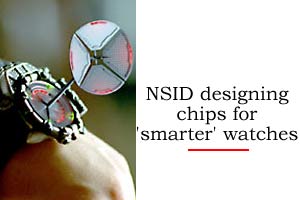Home > Business > Special
Priya Ganapati in Bangalore |
August 11, 2003

Wristwatches will not be just about time anymore. Come Christmas, a new breed of watches that, among other things, spew out stock quotes, weather updates, traffic information and even sports updates will hit the American markets.
Created by the world's leading watch brands and manufacturers, including Citizen Watch Co, Fossil Inc. and Suunto, these watches are being built using Microsoft Smart Personal Objects Technology (SPOT).
What makes India sit up and take note of this is that much of the design and implementation of the core chipset for these watches has been done by National Semiconductor India Designs in Bangalore.
Smart objects
Wristwatches incorporating SPOT constitute the first incarnation of 'smart' objects -- everyday devices whose core purposes are enhanced through easy-to-use software that Microsoft wants to bring to users.
The 'smart' objects will use Microsoft developed software to bring much of the services to the users.
Worldwide, Microsoft is in partnership with National Semiconductor to develop the chipsets that use embedded Microsoft software.
In the case of the wristwatches, the work landed at the doorstep of the National Semiconductor centre in Bangalore.
NSID, Microsoft in alliance
"National Semiconductor engineers have been working closely with their counterparts in Microsoft for over two years on SPOT to develop a complete solution that meets with Microsoft's stringent wireless information delivery network standards," says Ashok Kumar, Managing Director, National Semiconductor India Designs.
The project is a prestigious one, both for National and Microsoft.
SPOT has often been quoted as Microsoft Chairman Bill Gates' personal passion. At COMDEX Fall 2002 in Las Vegas, Gates introduced the SPOT Initiative, aimed at improving the function of everyday objects through the injection of software.
SPOT was incubated in Microsoft Research which has recently come out with products like the eBooks (Microsoft Reader) and the Tablet PC.
It tries to take everyday objects like clocks or watches to make them smarter, more personalised and more useful through the use of special software.
Marrying design with utility
Since these objects already have primary functions that people find valuable, the goal is to improve on them to make the variant not just useful, but indispensable.
With the wristwatches, there were a few parameters that had to be kept in mind, while designing them. The device had to be tiny and have high built-in security levels.
Most importantly, it had to be practical and cost-effective enough to afford high-volume manufacturability.
At the heart of the digital watch is a two-chip chipset. The first is the baseband microcontroller with Digital Signal Processing accelerators and the second is a custom-designed FM radio chip, which is the receiver chip.
The receiver chip receives the wireless data via the FM infrastructure and the 'micro-controller' chip processes this data.
It is the micro-controller chip that was completely designed at the Bangalore design centre.
"We achieved a design-cycle time of four months with concurrent development of Silicon, driver software and validation boards and by reusing some peripherals," says Kumar.
'An exciting project'
A subsidiary of National Semiconductors, the Bangalore design centre has about 70 engineers providing complete solutions in system-on-a-chip for imaging, wireless and display markets, custom VLSI CAD software and embedded software for National ICs.
Working with Microsoft on the SPOT-enabled watches is, however, the most exciting project to come out of the National stable in India.
"It is extremely exciting to be on this project for the kind of work it offers. It also has helped focus a lot of attention on the work we do here," says Kumar.
SPOT-enabled digital watches are expected to retail in the United States by Christmas and are likely to cost upwards of $50.
More smart devices soon
There are ideas for many such information packed appliances in the pipeline.
Alarm clocks, pens, buttons, key chains---all of which be turned into information packed devices.
"We are currently defining the derivative products for Microsoft. Essentially the micro controller remains the same. There will be some modifications made to it in keeping with the different devices in which they are likely to be used," says Kumar.